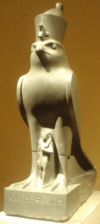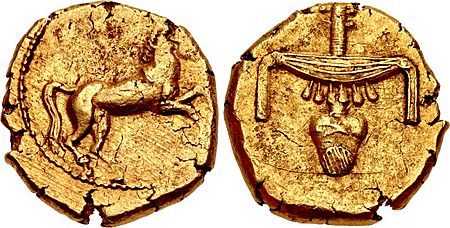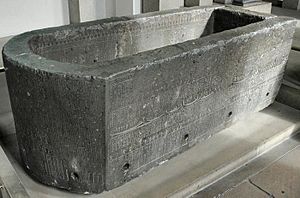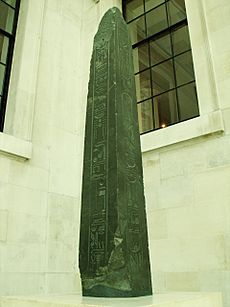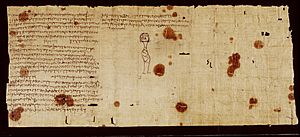Nectanebo II facts for kids
Quick facts for kids Nectanebo II |
|
|---|---|
| Nakhthorheb | |
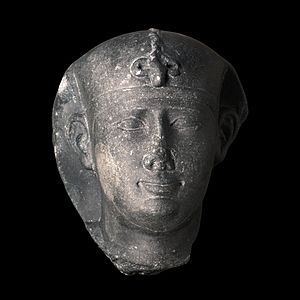
Head of Nectanebo II, Museum of Fine Arts of Lyon
|
|
| Pharaoh | |
| Reign | 358–340 BC (Thirtieth Dynasty) |
| Predecessor | Teos |
| Successor | Artaxerxes III |
| Father | Tjahapimu |
| Born | c. 380 BC |
| Died | After 340 BC |
Nectanebo II was the very last native ruler of Ancient Egypt. He was also the third and final pharaoh from the Thirtieth Dynasty of Egypt. He ruled Egypt from 358 to 340 BC.
During Nectanebo II's time, Egypt was very successful. Artists developed a special style that influenced later Egyptian art. Like his grandfather, Nectanebo I, Nectanebo II was very devoted to the gods. Over a hundred Egyptian sites show signs of his care. He built and restored more temples than Nectanebo I, including the huge Egyptian temple of Isis at Philae.
For several years, Nectanebo II kept Egypt safe from the Achaemenid Empire (the Persian Empire). However, he was eventually defeated by the Persians. His former helper, Mentor of Rhodes, betrayed him. The Persians took over Memphis and then the rest of Egypt. The country became part of the Achaemenid Empire under Artaxerxes III. Nectanebo fled south and kept some power for a while. What happened to him after that is not known.
Contents
Understanding Nectanebo's Name
The name Nectanebo comes from the Greek version of his name, Nectanebos. His Egyptian name was Nḫt-Ḥr-Ḥbt. This means "victorious is Horus of Hebyt".
Even though he and his grandfather, Nectanebo I, have similar names in English, their original Greek names were different. His grandfather was called Nectanebis. Medieval Arab writers called Nectanebo II Naqatanibas.
How We Know What Nectanebo Looked Like
There is a small statue made of a dark stone called greywacke at the Metropolitan Museum of Art. It shows Nectanebo II standing in front of the god Horus. This is one of the few known portraits of Nectanebo II that is clearly labeled.
In this statue, Nectanebo II wears a nemes (a striped headcloth) and a uraeus (a cobra symbol on his forehead). His bent arm with a sword forms the hieroglyph for nakht (victory). The falcon represents Horus, and the symbol in his right hand means heb. Other statues believed to be of Nectanebo II include heads made of quartzite and basalt.
Nectanebo's Journey to Power
In 525 BC, the Persian Achaemenid Empire conquered Egypt. But because of problems within the Persian Empire, Egypt became independent again in 404 BC. In 389 BC, Pharaoh Hakor made a deal with Athens. For three years, from 385 to 383 BC, Egypt fought off Persian attacks.
After a peace treaty in 387 BC between the Persians and the Greek city-states, Egypt and Cyprus were the only places preventing Persia from controlling the Mediterranean Sea.
In 360 BC, Nectanebo's uncle, Teos, who was pharaoh before him, began preparing for war against the Persians. Nectanebo II went with his uncle on this campaign. He was in charge of the machimoi, who were Egyptian warrior-farmers.
To pay for the war, Teos taxed Egyptians and took property from temples. Egyptians, especially priests, did not like these actions. They supported Nectanebo II instead. Teos asked for help from the Spartan military leader Agesilaus and the Athenian general Chabrias. Agesilaus said he was there to help Egypt, not to fight against it. Chabrias went home. Teos then fled to the Persian court, where he later died.
Nectanebo then had to deal with someone else who claimed to be pharaoh. This person was from the town of Mendes. He was likely a descendant of Nepherites I, whose family had ruled Mendes before. The claimant tried to get Agesilaus to join his side. But Agesilaus stayed loyal to Nectanebo. Nectanebo and Agesilaus were surrounded by the rebel's troops in the Nile Delta. Even though the enemy had more soldiers, Nectanebo and Agesilaus won. The rebellion ended in the fall of 360 BC. Nectanebo thanked Agesilaus by sending him a large amount of gold.
Nectanebo's Rule as Pharaoh
Religion was very important in Nectanebo's rule within Egypt. He started his reign by leading the funeral for an Apis bull in Memphis. He also added decorations to the Apis temples there.
Nectanebo II built important temples, including one for Khnum in Abu and one for Amun at Sekhtam. He also dedicated a shrine to Anhur-Shu. Nectanebo II also made the Buchis bull cult more popular. He even issued a rule that stopped stone quarrying in the "Mysterious Mountains" near Abydos.
Nectanebo II's foreign policy was mostly about stopping the Persians from taking over Egypt again. Before Nectanebo II became pharaoh, the Persians had tried to reclaim Egypt several times. Nectanebo used the peaceful times to build a new army. He hired Greek soldiers, which was common back then.
Around 351 BC, the Persian Empire tried again to conquer Egypt. After a year of fighting, Nectanebo and his Greek generals, Diophantus and Lamius of Sparta, managed to defeat the Persians. After this big victory, his people called Nectanebo II "Nectanebo the divine falcon." They even started religious groups in his name.
In 345/344 BC, Nectanebo supported a rebellion in Phoenicia against the Persian Empire. He sent 4,000 Greek soldiers, led by Mentor of Rhodes. However, when the Persian army, led by Artaxerxes III, approached, Mentor betrayed Nectanebo. He worked with the Phoenician king, Tennes, to help the Persians.
In late 344 BC, Persian messengers went to Greece to ask for help against Egypt. Athens and Sparta were polite but did not join the Persians. Other cities, like Thebes and Argos, did send soldiers to help the Persians.
In the winter of 343 BC, Artaxerxes set off for Egypt. Nectanebo's army had 60,000 Egyptians, 20,000 Libyans, and many Greek soldiers. Nectanebo also had special boats to stop enemies from entering the Nile through its mouths. Strong forts and camps protected Egypt's borders. The Persian forces were made stronger by Mentor and his men, who knew Egypt's eastern border well. They also had 6,000 Ionians.
Nectanebo II was finally defeated. In the summer of 342 BC, Artaxerxes entered Memphis and put a Persian governor in charge. Nectanebo fled to Upper Egypt and then to Nubia. He was given a safe place there and kept some power for a while. With help from Khabash, Nectanebo tried to get his throne back, but he failed.
Nectanebo's Lasting Impact
Even though Nectanebo ruled during a difficult time and was the last pharaoh of an independent Egypt, he was a very active builder. He likely built as much as many great kings from earlier times. His name has been found in almost all major religious centers. His devotion to the gods was like that of the great kings of the past.
Nectanebo II built and improved temples all over Egypt. He gave many gifts to the priests at the places he supported. His name has been found in places like Heliopolis, Athribis, and Bubastis in the Nile Delta. But he built the most at Sebennytos, including the modern site of Behbeit El Hagar. The art in the temples at Sebennytos influenced later art in the Ptolemaic Kingdom. He focused on religious buildings probably to show that his rule was rightful, since he had taken the throne from his uncle.
Nectanebo in the Alexander Romance
There is a famous story, not entirely true, called the Alexander romance. It tells a different ending for the last native pharaoh. The story says that after Nectanebo II lost his last battle, he did not go to Nubia. Instead, he went to the court of Philip II of Macedon (Alexander the Great's father). He pretended to be an Egyptian magician.
While Philip was away fighting, Nectanebo disguised himself as the god Amun. He convinced Philip's wife, Olympias, that Amun would visit her and they would have a son. This son, according to the story, was Alexander the Great.
This myth was very popular with Egyptians. They wanted to believe in a connection to their old rulers and disliked foreign rule. In art, Nectanebo is sometimes shown with dragon-like features in this story.
In an older story from the early Ptolemaic Kingdom, Nectanebo has a dream about Isis. In the dream, the god Onuris is angry because Nectanebo's temple in Sebennytos is not finished. Nectanebo calls the best sculptor, Petesis, to finish the job. But Petesis gets distracted by a beautiful girl and messes up his task. The story ends there, but it probably led to the fall of Egypt.
The legend of Nectanebo had a big impact on European culture up to the Renaissance and beyond. He is even included in the Sola Busca tarot card deck, along with other characters from the Alexander legend like Alexander, Philip, Olympias, and Amun. Some scholars believe Natanabo in the tarot represents a messenger who brings a gift, like a helmet, symbolizing strength and protection.
See also
 In Spanish: Nectanebo II para niños
In Spanish: Nectanebo II para niños


